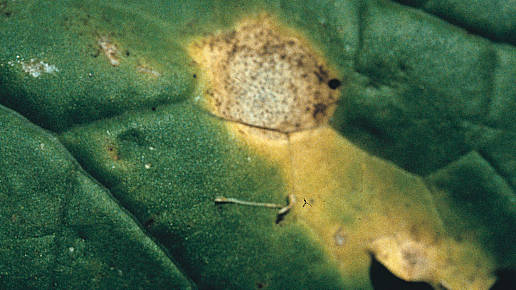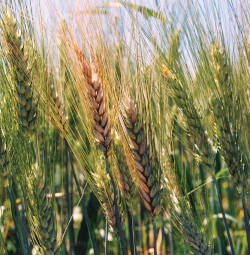
As climate, weather patterns, crop rotations and management practices change, disease concerns will shift so growers need to keep on top of and track what’s in their field throughout the entire growing season.
“I like to see lots of growers walking with a hoe throughout the season,” says Albert Tenuta, field crop pathologist with the Ontario Ministry of Agriculture, Food and Rural Affairs. “Whether it’s growers — or their consultant or company representative — they need to be walking and observing to have a good handle of what’s happening in the crop in real time.”
Scouting helps provide growers with the benchmarks needed to make necessary decisions in the current season, the following season and during the next rotation to the same crop. It also provides the opportunity for growers to determine how their management practices have worked, and to see if there have been shifts in a familiar pest.

Fusarium head blight is a fungal disease that can infect a number of crops including barley (pictured here), wheat, oats, rye and corn.
“Soybean cyst nematode is a good example of a disease that has changed over time,” says Tenuta. “It first became a problem in the late 1980s, and then with resistant varieties it went from causing 50 per cent yield loss to less than five per cent yield loss. But now it is starting to adapt. You can’t just look at your yield monitor to track it, you need to see the impact it is having in your field in order to react to it.”
By the same token, some diseases are now so routine they show up annually, varying only by what area of the country you farm, and what the weather is like when the crop is at the right stage for infection.
“Just before the cereal crop comes into anthesis, for example, you need to evaluate for fusarium head blight every single year, using local risk assessment tools,” says Michael Harding, a research scientist with Alberta Agriculture and Forestry. “Sclerotinia shows up pretty much every year, just to varying levels of severity. Rotation and other tools help, but every year growers continue to have to watch the weather when the crop is at risk.”
OLD AND NEW ENEMIES
Over the past year, conditions for disease growth in Alberta have been low. While cold springs have meant a higher potential for root and seedling rots, that risk has been somewhat mitigated through good seed genetics and effective seed treatments.

Soybean cyst nematode is a plant-parasitic round worm. The cyst refers to the egg-filled body of the dead female and can contain up to 400 eggs.
“It’s really been too dry for many of the traditional diseases,” says Harding. “Blackleg in canola can generally be managed with resistant varieties and we have seen few signs, as yet, of disease resistance breaking down. While clubroot continues to spread, the only way to check for it is to pull your roots, so we tell growers to watch for, and catch it early, so they are better able to manage it.”
The pathogens for most common diseases are well established across Canada, so there are some diseases that growers need to look for every year. “In Saskatchewan, growers often pencil in a fungicide application for diseases such as anthracnose, sclerotinia and fusarium head blight, but the final decision to apply the fungicide should be based on the environmental conditions and in-season risk,” says Barbara Ziesman, plant disease specialist with the Government of Saskatchewan.
Some of the recent disease trends in Saskatchewan include Group 11 fungicide insensitivity in the anthracnose pathogen. And while root rots continue to be prevalent in pulse crops, clubroot is something all canola growers should watch for as it makes steady inroads into the province.
In Ontario, Tenuta says 2019’s rainy spring meant that it was too wet for some diseases to develop, while others flourished. “We had soybean cyst nematode along with sudden death syndrome in some areas more than others and we had some fusarium head blight,” he says. “Foliar diseases including northern corn leaf blight and rusts were an issue for many growers. White mould was an issue in areas with cooler, moderate weather. But growers who were consistent with their crop management saw strong yields.”
TRACKING YOUR RISK
Keeping on top of disease shifts is important, and growers should track their risk levels by keeping records of what they see each year, from the time they put their seed in the soil, through to harvest. This not only allows them to plan their rotation, it allows them to anticipate what disease they could potentially expect several years down the road.

Clubroot is a soil-borne disease of cruciferous plants such as canola. Galls form on the roots leading to premature death of the plant.
“You always think you are going to remember but with so many fields and so many crops over several years it’s important to have that written history,” says Harding. “Did you have root rot, did you have stem rot or foliar blight? The best way to know for sure is take a look at your records. It will also help you track if climate has had an impact on disease on your farm.”
“I think record keeping is underused by growers,” adds Ziesman. “It is especially important to guide crop rotations and future disease management. By looking back at your records from previous years, you are able to validate if a particular strategy worked, or catch the first hints of a shift towards resistance.”
There are numerous ways growers can keep records. While traditional manual record keeping isn’t going anywhere, today there are countless applications that record data effortlessly, including electronic platforms that are integrated from the sprayer, to the planter through the harvester to provide records that are automated and data that is more robust.
A SHIFTING CLIMATE
Climate and weather are not the same things, to be sure. But a changing climate is influencing weather patterns and farmers need to be attentive to those changes.
“Growers have to stay on their toes in terms of crop diseases related to changing climate,” says Harding. “For example, large storm fronts that travel long distances can move dirt and dust along with bacterial pathogens. Weather also affects insects and their migration, and the Prairies has seen insects in recent years that it hasn’t seen before.”
Ziesman says that while drier conditions on the Prairies in recent years has reduced disease inoculum and the potential for outbreak, the high winds and hail associated with storms can wound plants and create vectors for disease.

Blackleg is a serious disease in canola caused by two species of fungi and in susceptible varieties, can result in significant yield losses.
In Eastern Canada, Tenuta says that climate change could have an impact on rusts as they creep up on winds from the Midwest bringing spores closer earlier, plus milder winters could allow spores to overwinter on green plants. He also thinks that if the weather warms significantly, that could also increase pythium species in corn and soybeans.
“It’s important that we start benchmarking at this point so that we can know the impacts of changing climate,” says Tenuta. “In Ontario we do a lot of surveys. We track soybean cyst nematode, foliar diseases and ear rots in corn, for example, and we compare them against our U.S. counterparts.
“We are part of the Crop Protection Network (cropprotectionnetwork.org) that tracks disease losses over time,” he says. “This helps us anticipate change from diseases over time. The environment is one of the three pillars in the disease triangle. Climate change will benefit some diseases, reduce others and have no impact on others. But it is important that growers, researchers and extension keep an eye on it all.”